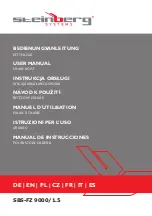
www.tigerlifting.com
Unit 1, Greensfield Industrial Estate,
Willowburn Avenue,
ALNWICK, NE66 2DG
Email: [email protected]
www.tigerlifting.com
Page 11 of 38
Manual Tiger SS11-PLH En 201704 v3.2
5.
Inspection
According to national and international accident prevention and safety regulations (for example LOLER for the UK), hoisting
equipment must be inspected:
in accordance with the risk assessment of the operating company
prior to initial operation
before the unit is put into service for any subsequent use
after substantial changes
however, at least once per year, by a competent person.
Note:
Actual operating conditions (e.g. operation in galvanizing facilities) can dictate shorter inspection intervals.
The intervals of inspection must be determined by the individual application and are based upon the type of service to which
the lever hoist will be subjected.
The SS11 lever hoist meets the requirements of IMCA document D 028 Rev.1 February 2008 section 7.4 immersion policy.
Prior to initial operation, before it is put into operation again and after substantial changes
Before the unit is put into operation, for the first time, for a subsequent use or after substantial repair or modification, unless
you have received physical evidence that a thorough examination has been carried out which shows that the lever hoist is
safe to use, it should be thoroughly examined by a competent person in compliance with applicable statutory regulations.
Typical pre-use inspection will consist of a visual inspection and a function check. These inspections are intended to establish
that the hoist is in a safe condition, has been set up appropriately and is ready for operation, and that any defects or damage
are detected and eliminated.
Inspect the lever hoist for operation warning notices and legibility. Deficiencies should be noted and brought to the attention
of supervisors. Be sure defective lever hoists are tagged and taken out of service until repairs are made. Under no
circumstances should you operate a malfunctioning lever hoist.
The following checks should be carried out before starting work:
Check the unit
Inspect the unit for visual defects, e.g. deformations, damage, cracks, wear and corrosion marks.
Check that the name plate/label showing the hoist capacity is attached and clearly legible.
Check lubrication and lubricate if necessary.
Check for loose or missing nuts and for missing split pins.
Inspect the supporting structure and attachment point
Inspect the supporting structure for visual defects, e.g. deformations, damage, cracks, wear and corrosion marks.
The attachment point for the hoist must be selected so that the supporting structure to which it is to be fitted has sufficient
stability and to ensure that the expected forces can be safely absorbed. The unit must align freely also under load in order to
avoid impermissible additional loading. Check that the hoist and the load are correctly attached. The selection and calculation
of the appropriate supporting structure are the responsibility of the operating company.
If the brake does not function properly, the unit must be immediately removed from service and placed in a quarantine
area until it can be repaired by a relevant competent person.
! WARNING


































